We'd embarked on a big expansion plan, but these things still take time to get through the system. We went through a
tendering process for massive log-aperiodic aerials and 50 kilowatt transmitters and then placed the orders. Meanwhile broadcasting went on as usual - well, not exactly as usual.
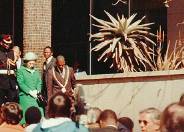 In 1979 the Commonwealth Conference was held in Zambia and while Britain's Queen Elizabeth II was in the region she came to
Gaborone as Head of the Commonwealth. Here she is coming down the steps of the Botswana Housing Corporation building with the Mayor of Gaborone at the start of her State Visit.
In 1979 the Commonwealth Conference was held in Zambia and while Britain's Queen Elizabeth II was in the region she came to
Gaborone as Head of the Commonwealth. Here she is coming down the steps of the Botswana Housing Corporation building with the Mayor of Gaborone at the start of her State Visit.
As well as attending the usual round of VIP receptions I had an official role to fulfil for Radio Botswana. At one point I found myself setting up microphones and public address at the State Banquet, held in Gaborone's 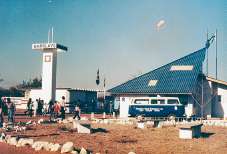 Holiday Inn - but then I had to stand
hungrily behind the Queen while the meal was consumed!
Holiday Inn - but then I had to stand
hungrily behind the Queen while the meal was consumed!
The visit coincided with the annual Gaborone Trade Fair and boy, were we busy! The whole place was cleaned up. We'd seen plenty of Heads of State
before but somehow a little bit more effort was put in this time.
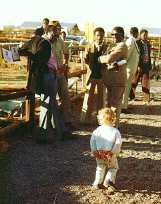 One of our treasured moments is captured here. I happened to have the camera ready when our daughter Si‚n (who was just coming up to two years old) decided to go for a look round on her
own. In the process she walked up to His Excellency President Khama (dark jacket, on the left) whilst he was relaxing at the Trade Fair after the Queen had left the country. Everyone
was quite unconcerned - security was a very low-key affair.
One of our treasured moments is captured here. I happened to have the camera ready when our daughter Si‚n (who was just coming up to two years old) decided to go for a look round on her
own. In the process she walked up to His Excellency President Khama (dark jacket, on the left) whilst he was relaxing at the Trade Fair after the Queen had left the country. Everyone
was quite unconcerned - security was a very low-key affair.
A regular feature of occasions like this was the appearance of the Botswana Defence Force 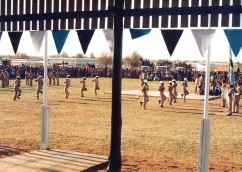 band. They didn't confine themselves to merely playing their instruments,
but would perform dances and formation marching to the delight of the crowd.
band. They didn't confine themselves to merely playing their instruments,
but would perform dances and formation marching to the delight of the crowd.
More celebrations
1979 was the year when our son, Michael, was born. We gave him the
name "Kagiso" as well, which means "peace" or "blessings" in Setswana. It's a lovely name and now I could
legitimately be called "Rra-go-Kagiso" rather than "Rra-go-Si‚n". Mind you, people used both anyway. Ted and his wife Rita gave us a sheep to
celebrate the new arrival. I'm ashamed to say that we were a bit non-plussed by this, as it's not something one is used to in England. In the end, we took the sheep to the local abbatoir and froze the meat for future
use. What we should have done is have a large feast, inviting all the neighbours and our friends. Ted, if you ever read this, I apologise for not
really getting to grips with that. We never really got to grips with the need to leave meat in the fridge for three weeks before cooking it, either - the local butchers didn't hang it!
By this time I'd been in Botswana five years, three of them as Chief Engineer of Radio Botswana. Pru had done some teaching before giving it up when we had the children. We were half-way through our time in the
country, although we'd never expected to be there that long and certainly didn't think we'd still be there for yet another five years!
Death of a President
In 1923, when he was three, Seretse Khama inherited the leadership of the Bamangwato people (one of the main Batswana tribes) after his grandfather and father both died within two years of each other. After his
accession in 1950, he caused a furore by marrying a white English woman,  Ruth, during his law studies in London. The
racist regimes in South Africa and Rhodesia objected violently and the tribe was none too pleased either. Seretse was forced to stand down as Chief of the Ngwato, and he was held in exile in the UK until 1956.
Ruth, during his law studies in London. The
racist regimes in South Africa and Rhodesia objected violently and the tribe was none too pleased either. Seretse was forced to stand down as Chief of the Ngwato, and he was held in exile in the UK until 1956.
When he finally returned to Bechuanaland (as it was then), Seretse pressed for change. In the early 1960s he founded the Botswana Democratic Party, with policies which retained traditional influence but
sought modern democratic independence from Britain, under whose "protection" the country had languished for the past eighty years. In 1965 the BDP overwhelmingly won pre-independence elections, and in 1966
Seretse Khama was sworn in as President of the new, non-racial Republic of Botswana. Britain gave him a knighthood and his wife - the English typist - became Lady Ruth Khama.
Over the next decade President Sir Seretse Khama steered his country along a precarious tightrope as one of the "front-line" states. He was one of the main architects of SADCC - the Southern Africa Development
Coordination Conference. Just as it was beginning to take shape in 1980, he died. The country was devastated. He was only 59.
 I can remember the morning the death was announced. We'd been expecting it for some time and went to bed the night before knowing that the end was likely to
come within the next 24 hours. At 5 am I was awakened by a call from the Minister of Public Service and Information, Daniel Kwelagobe, who'd been up all night at State House. It then fell to me to tell the
world officially, which I did by dashing into Radio Botswana and composing a telex to the BBC's World Service newsroom. (Actually, I phoned them first, but they wanted written confirmation). Twenty
minutes later, I heard the sombre headline at the top of the World Service bulletin.
I can remember the morning the death was announced. We'd been expecting it for some time and went to bed the night before knowing that the end was likely to
come within the next 24 hours. At 5 am I was awakened by a call from the Minister of Public Service and Information, Daniel Kwelagobe, who'd been up all night at State House. It then fell to me to tell the
world officially, which I did by dashing into Radio Botswana and composing a telex to the BBC's World Service newsroom. (Actually, I phoned them first, but they wanted written confirmation). Twenty
minutes later, I heard the sombre headline at the top of the World Service bulletin.
Sir Seretse died just as we were about to return to the UK for three
months' leave. We'd already twice extended our second tour of duty past the official limits and everyone insisted that we go home despite the awful
news. As a result the picture (above) from the Daily News is the only one I have of the funeral. It was held at Serowe, the Bamangwato capital - Seretse Khama was buried with his ancestors.
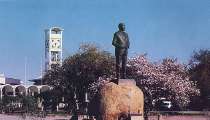 Dr. Quett Masire, the Vice-President, succeeded to the Presidency. A few
years later a memorial statue of President Khama was erected in front of the National Assembly. I've never actually seen this statue because it was completed after I left, but here's a
picture of it. It's about 200 metres from Radio Botswana's front gate.
Dr. Quett Masire, the Vice-President, succeeded to the Presidency. A few
years later a memorial statue of President Khama was erected in front of the National Assembly. I've never actually seen this statue because it was completed after I left, but here's a
picture of it. It's about 200 metres from Radio Botswana's front gate.